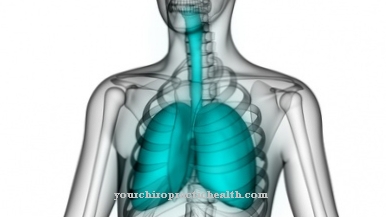A caress of the cheek or the corner of the mouth is enough to get the Search reflex to trigger a baby. It is one of the most important early childhood reflexes and initiates the newborn's search for the mother's breast or the bottle of milk. The baby turns its head in the direction of the touch and opens its mouth to suckle. Just a few days after the birth, it can skillfully work its way to the mother's breast (breast crawl). The search reflex (also Rooting reflex) is particularly severe during the first 30 minutes after giving birth. It lasts until around the third or fourth month of life and then disappears by itself. Only in some babies can the search reflex be stimulated longer in their sleep. The awake child then finds the breast or bottle with its sensory organs independently.
What is the search reflex?

The early childhood (primitive) reflexes are responses of a newborn to external stimuli that are related to the search for and intake of food as well as self-protection. They initially take place without the direct involvement of the cerebrum. Only in later developmental phases of the cerebrum are the reflexes inhibited by the frontal lobes.
The gradual disappearance of the primitive reflexes is a prerequisite for normal physical and mental development of the child. If the reflexes persist longer than usual, this can result in disorders of motor skills and general mobility. These should be compensated by the doctor in good time.
On the other hand, the reappearance of early childhood reflexes in adulthood can reveal specific damage to the brain, for example in dementia.
The baby absorbs the irritation with receptors on the skin or with its sense of balance. His reflexes arise according to a concrete schedule, which is based on the conception age and therefore begins with the conception of the child.
The coming and going of the early childhood reflexes can be timed relatively precisely. In addition to the search reflex, these include, for example, the swallowing reflex, sucking reflex and grasping reflex. They all follow a specific, precisely defined reaction pattern. A special form is the so-called Moro reflex, with which the baby clings to a caregiver so as not to fall off. This is more of a typical reaction to a specific danger.
Function & task
The search reflex arises from the baby's programming to eat. Immediately after birth, he instinctively looks for his mother's breast or a comparable source of food. Like other reflexes, the fetus learns the search reflex in the womb.
Once born, every baby develops amazing skills to satisfy their hunger. Very early on, it can move its legs and feet bit by bit to the mother's chest when it lies on its stomach. It cannot be stopped from this so-called breast crawl, as it wants and has to satisfy its hunger. In addition, the mother's breast secretes a secretion, the taste and smell of which reminds the baby of the amniotic fluid that surrounded it in the pregnant woman's womb.
Thanks to the sucking reflex, the baby will usually not choke while drinking. In addition, the newborn is also inspired by direct skin contact and the range of vision to the mother. Breastfeeding also has a positive effect on the relationship between mother and child. The mutual relationship becomes particularly close in the baby's first days of life.
For the mother, the search reflex is also the signal that her baby is hungry. Because only when it wants to drink will it display the typical reflex behavior. The baby is guided by the smell of his mother's breast from the start. Should the baby turn her head away while breastfeeding, the mother only needs to touch his cheek or lip with the nipple and can thus stimulate the search reflex again.
However, the child must not be irritated by external stimuli on the head while drinking, because in this case they will always turn their head away in the appropriate direction. Any pressure on the back of the baby's head should also be avoided, for example by pushing the baby to the chest. Then the infant reacts with counter pressure and may suddenly turn away from the mother's breast.
Illnesses & ailments
If the search reflex is weak or not developed at all in a baby, it can be activated with special oral massages. Midwives and paediatricians provide the right instructions for this.
Problems with sucking and drinking can be related to the lack of a vacuum between the mouth and nipple. In such cases, the wart should be supported with the thumb to prevent it from slipping out of the mouth. The baby's body position may also need to be improved so that it can suckle more comfortably.
Sometimes it is necessary to press the breast against the baby's mouth repeatedly. However, there must still be enough air to get to the newborn's nose.













.jpg)

.jpg)
.jpg)











.jpg)